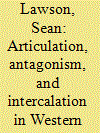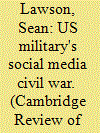| Srl | Item |
| 1 |
ID:
104024


|
|
|
|
|
| Publication |
2011.
|
| Summary/Abstract |
This article provides a discursive grounding for understanding the construction of military imaginaries by adding the concepts of 'antagonism' and 'intercalation' to articulation theory. By examining the cases of industrial-mechanized warfare theory and network-centric warfare theory through the lens of this expanded articulation theory, it is argued that military imaginaries often serve to define and link conceptions of science, technology, society, economy, war, and military organization, thought, and practice into a unified image of the larger security environment - that is, the military imaginary. Military imaginaries often share a common narrative structure that privileges co-periodized change among the elements of the articulation, resulting in the phenomenon of 'antagonism' serving as a generic threat used to justify military modernization and even the use of force.
|
|
|
|
|
|
|
|
|
|
|
|
|
|
|
|
| 2 |
ID:
132050


|
|
|
|
|
| Publication |
2014.
|
| Summary/Abstract |
This article uses the controversy within the United States (US) military over the use of social media by individual military professionals as a window into larger debates about the nature of information-age conflict. Information and associated technologies are now central to the US military imaginary. But the controversy over social media is one indicator that the dominant discourse of information-age conflict is neither stable nor total. The introduction of a new technology can serve as an antagonism that turns latent, potential contradictions into substantive differences for policymaking. Thus, though the US military generally has embraced information and communication technologies (ICTs), the introduction of a particular ICT can still be a source of controversy. Military imaginaries, technologies and the relationships between them remain dynamic, contingent and sometimes contentious.
|
|
|
|
|
|
|
|
|
|
|
|
|
|
|
|